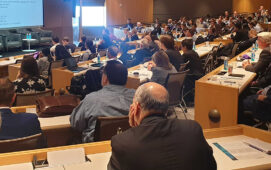The Global Legal Entity Identifier System (GLEIS) has taken a major step forward with the establishment and first meeting of the Global LEI Foundation (GLEIF). The foundation will develop the Central Operating Unit (COU) of the GLEIS and take over management of the system from the Regulatory Oversight Committee (ROC) of the LEI over the coming year.
Welcoming the first meeting of the foundation, the ROC stated that all pre-LEIs issued to data will move unchanged into the system managed by the foundation and all pre-LEIs issued by endorsed pre-Local Operating Units (LOUs) will become LEIs immediately.
The GLEIF has been established in Basle by the Financial Stability Board (FSB), which started the process of developing the GLEIS back in June 2012, and held its inaugural meeting in Zurich last week. The foundation will be supervised by the ROC and has the purpose of serving the broad public interest as the operational arm of the GLEIS, supporting on a not-for-profit basis the implementation and use of the LEI and associated data to uniquely identify entities that engage in financial transactions. To do this, it will develop and oversee the long-awaited COU.
ROC chairs Matthew Reed, Bertrand Couillault and Jun Mizuguchi described the establishment of the foundation as ‘a pivotal day for the GLEIS’. Reed, who is also chief counsel of the Office of Financial Research, explains: “The global LEI system is building momentum. After two years of work and strong cooperation among industry and government, the formal establishment of the Global Legal Entity Identifier Foundation is a major achievement. The foundation will be the heart of the LEI system, building its technology infrastructure and ensuring adherence to governing principles and standards, including reliability, quality and uniqueness.”
The chair of the GLEIF board, Gerard Hartsink, adds: “We have an important job ahead of us to build up the operations of the GLEIS and ensure that it conforms with the recommendations endorsed by the G20 [in June 2012]. We will coordinate with LOUs endorsed by the ROC to ensure that we establish a strong partnership between the GLEIF and the LOUs.”
Hartsink will lead a board of directors with 16 members, all of whom were proposed as nominees to the board by the FSB, based on a recommendation from the ROC, in January 2014.
While the transition of the GLEIS from an interim to a complete system, and the transition of its management from the ROC to the GLEIF is expected to happen over the coming year, an immediate result of the establishment of the GLEIF is that all LEIs issued by endorsed pre-LOUs will no longer be considered as interim and will be called LEIs, rather than pre-LEIs. The transition will also move all LEIs issued to date unchanged into the complete system managed by the GLEIF.
The interim system established in 2013 and supervised by the ROC includes 16 endorsed pre-LOUs that have assigned almost 300,000 pre-LEI codes to entities from more than 150 countries. A further 12 pre-LOUs have been granted prefixes to support planning and development in advance of introducing operational platforms.
Outlining the journey from June 2012 to the establishment of the GLEIF, the ROC states: “This day is an important milestone, completing the establishment of the three-tier structure of the Global LEI System – ROC, GLEIF and Local Units – endorsed by the G20 in Los Cabos in June 2012 on the basis of recommendations of the FSB. The ROC was established in January 2013 to uphold the governance principles of, and to oversee, the Global LEI System in the broad public interest. These principles include assuring that the system produces high quality freely available data about entities operating in financial markets on a globally consistent basis. Over the past two years, over 60 public sector authorities from close to 40 jurisdictions have worked cooperatively to establish a governance framework, create the operational capacity to deliver LEIs by local pre-LOUs, and undertake the preparatory work to support the establishment of the foundation to manage the central operations of the system.”
Subscribe to our newsletter




